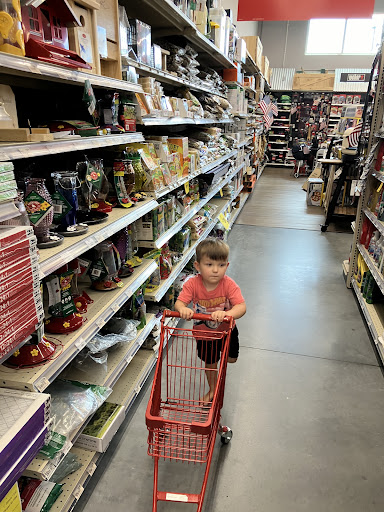Hose Bib Repair Kit: Simple Fixes 2025
Stop the Drip and Save Water
A hose bib repair kit is your go-to solution for a leaky outdoor faucet. It’s a simple collection of parts designed to fix common drips and leaks without needing to replace the entire fixture. These kits save you money, conserve water, and often take less time than a full replacement. You can typically find them at local hardware stores, including your neighborhood Lowcountry Ace, and online. A basic kit usually costs under $30, making it a very affordable DIY project.
Here’s a quick overview of what a hose bib repair kit offers:
- What it is: A pre-packaged set of common replacement parts for outdoor faucets.
- What it solves: Leaks from the handle, dripping spouts, or minor issues with the valve stem or packing.
- Benefits: Cost-effective, prevents water waste, and avoids a full faucet replacement.
- Where to buy: Hardware stores and online retailers.
- Typical cost: Usually under $30 for a basic kit.
A dripping faucet might seem minor, but it can waste thousands of gallons of water each year. Fixing it saves you money on your water bill and protects your home from potential water damage.
The helpful team at Lowcountry Ace has years of experience assisting homeowners with all their plumbing needs, including finding the perfect hose bib repair kit for any leaky outdoor faucet. With the right kit and some guidance, you’ll be able to tackle this common home repair yourself.
Hose bib repair kit terms simplified:
First, Diagnose the Leak: Where Is the Water Coming From?
Alright, home heroes! Before you dive into fixing that leaky outdoor faucet with your trusty hose bib repair kit, let’s play a little detective game. The first step to a successful repair is figuring out exactly where that water is coming from. Is it a steady drip, or does it only leak when you turn the water on? Does the water sneak out around the handle, drip from the spout, or even worse, seem to come from the wall itself?
Pinpointing the leak’s source is super important. It tells us exactly which part of your hose bib needs a little love and attention.
You might notice common signs of a leaky hose bib: a wet patch on your patio, constant dripping even when the water is off, or maybe even a surprising jump in your water bill. Even a tiny drip can waste thousands of gallons of water each year, and nobody wants that!
Outdoor faucets, also called hose bibs, can spring leaks for a few reasons. Maybe it’s just everyday use, harsh weather and temperature changes, or even accidental bumps. Most often, though, a simple worn-out rubber washer is the culprit. But sometimes, it could be corrosion in the valve area, a loose packing nut, or even a small crack in the pipe or the spout itself, often due to frost damage. Knowing the cause helps you pick the right fix.
Want to dig deeper into how to spot the damage and stop future leaks? Check out this helpful guide: How to Repair, Replace & Prevent Leaky Hose Bibbs with SharkBite.
Common Leak Points and Their Causes
Here’s where those annoying drips often show up:
- Stem Leak / Packing Nut Leak: If water is seeping out right around the handle, or the stem (that’s the part you twist to turn the water on and off), you’re likely dealing with a problem under the packing nut. This usually means the packing string or a small O-ring has worn out. These parts create a tight seal around the stem, and over time, they can get old or dry.
- Spout Drip: This is probably the most common leak you’ll see. If water just keeps dripping from the spout, even when you’ve turned the faucet completely off, the issue is almost always with the compression washer. This little washer sits at the very end of the inner valve stem. Its job is to press against the valve seat and stop the water flow. When it gets old and worn, it can’t make that tight seal anymore.
- Vacuum Breaker Leak: Some newer hose bibs, especially those designed to prevent dirty water from flowing back into your home, have a small cap on top. This is called a vacuum breaker. If you see water leaking from this cap, it means the parts inside the vacuum breaker have probably given up. Don’t worry, this is often an easy fix!
- Wall Leak / Body Crack: Now, this one’s a bit more serious. If water is leaking right where the hose bib meets your house wall, or if you can actually see a crack in the faucet body, that’s a red flag. This often points to a faulty connection inside the wall or, even worse, damage from freezing temperatures that caused the metal to crack. If you see this, it needs your attention right away!
- Worn O-ring or Damaged Internal Components: Beyond the main washer and packing, your faucet has other tiny O-rings and seals inside. These can also wear out over time, leading to leaks. Sometimes, parts inside can even break due to age or if the faucet freezes, making it hard to use or causing constant drips.
Sometimes, these little drips can be tricky! They might look like just a bit of condensation on a humid day. But don’t let them fool you. If there’s consistent moisture, something needs fixing!
When to Repair vs. When to Replace
Once you’ve played detective and figured out where the leak is coming from, the next big question pops up: should you fix it with a hose bib repair kit or replace the whole thing? This choice usually depends on how bad the damage is, what makes the most sense for your wallet, and how comfortable you feel tackling DIY projects.
Here’s a simple guide to help you decide what’s best for your situation:
| Scenario | Repair (using a hose bib repair kit) | Replace (entire hose bib) |
|---|---|---|
| Leak Type | Minor drips from the handle, spout, or vacuum breaker. | Persistent leaks from the wall connection. Severe, uncontrolled leaks. |
| Cause | Worn washers, O-rings, packing string, or a faulty vacuum breaker. Loose packing nut. | Cracked faucet body (often due to frost damage). Severe corrosion that makes the faucet hard to turn or unsafe. Broken internal components that are difficult to source or costly to replace individually. |
| Cost-Effectiveness | Highly cost-effective. A typical hose bib repair kit is very affordable, often under $30. This is significantly cheaper than hiring a plumber or buying a new faucet. | More expensive. A new hose bib can cost anywhere from $20 to over $100, plus potential plumbing costs if you hire a professional. However, it can prevent more costly water damage in the long run. |
| DIY Project Scope | Generally a straightforward DIY project. Requires basic tools and a bit of patience. Most repairs can be completed in under an hour. | Can be a DIY project if you’re comfortable with more involved plumbing, especially if it involves soldering or working inside the wall. Often a job for a professional plumber, particularly if the leak is from the wall. |
| Faucet Condition | Faucet body is intact, no visible cracks or severe corrosion. Operates smoothly (aside from the leak). | Faucet is visibly cracked, severely corroded, or has been damaged by freezing temperatures. Hard to turn or seized. |
| Benefits | Saves money, conserves water, extends the life of your existing faucet, and gives you a great sense of accomplishment! | Provides a fresh start, ensures long-term reliability, and allows for upgrades (e.g., to a frost-free model). |
So, as a good rule of thumb: if the leak is just from a part you can easily swap out (like a washer, an O-ring, or the vacuum breaker), then a hose bib repair kit is your best friend. It’s quick, easy, and saves you money!
But if the main body of your hose bib is cracked, badly rusted, or if the inside parts are truly broken beyond simple repair, then replacing the whole unit is often the smarter, more lasting choice. No matter what you decide, the helpful team at Lowcountry Ace is here to lend a hand. We can help you figure out the problem and find just the right part or a brand-new faucet to get things flowing smoothly again!
How to Use a Hose Bib Repair Kit: A Step-by-Step Guide
Ready to tackle that drip? Using a hose bib repair kit is a rewarding DIY project that most homeowners can handle. We’ll walk you through the process, step by step. Safety first!
Before you begin, make sure you have all the necessary items on hand. You’ll likely need basic tools like a screwdriver, an adjustable wrench or channel-lock pliers, and of course, your chosen hose bib repair kit. For a comprehensive list of what you might need for various tasks, check out The Best Tools for Home Improvement.
Step 1: Shut Off the Water and Gather Your Tools
This is the most critical step. You absolutely must shut off the water supply to the hose bib before starting any work.
- Locate the Shut-Off Valve: Ideally, your outdoor hose bib has a dedicated shut-off valve inside your home, usually in the basement or crawl space, on the pipe leading to the faucet. If not, you’ll need to turn off the main water supply to your entire house.
- Turn Off the Water: Close the valve completely.
- Drain the Line: Go back to the outdoor hose bib and turn it on to drain any remaining water from the line. Leave it in the “on” position while you work to ensure no pressure builds up.
- Gather Your Tools: Lay out your screwdriver (Phillips or flathead, depending on your handle screw), adjustable wrench or channel-lock pliers, rags, a small bucket (for any residual water), and your hose bib repair kit. For more general advice on tackling projects around the house, see our guide on DIY Home Improvement.
Step 2: Disassemble the Hose Bib
Now that the water is off and your tools are ready, it’s time to carefully take apart the hose bib.
- Remove the Handle: Use your screwdriver to remove the screw holding the handle in place. Once the screw is out, the handle should pull straight off.
- Remove the Packing Nut: This is the nut located directly behind where the handle was, usually hexagonal. Using your adjustable wrench or channel-lock pliers, carefully unscrew the packing nut. It might be a bit stiff, especially if it’s been there for a while.
- Extract the Valve Stem: Once the packing nut is off, you should be able to pull the entire valve stem assembly out of the faucet body. For frost-free models, this stem will be quite long. Pull it straight out.
Step 3: Replace the Worn-Out Parts
With the valve stem in your hand, you can now identify and replace the worn components that were causing the leak.
- Inspect the Stem Washer: At the very end of the valve stem, you’ll find a small rubber or neoprene washer, usually held in place by a screw. This is the compression washer. Remove the screw and the old washer. It’s often flattened, cracked, or hardened.
- Replace the Stem Washer: Select an exact replacement from your hose bib repair kit. It’s crucial that the new washer matches the old one in size and thickness. Insert the new washer and secure it with the screw.
- Inspect the Packing/O-rings: Look at the stem where the packing nut was. You might find old packing string wrapped around it, or one or more O-rings. If using packing string, carefully unwrap the old material. If using O-rings, gently pry them off.
- Replace the Packing/O-rings: Wrap several loops of new graphite packing string clockwise around the stem, or slide on the new O-rings from your hose bib repair kit. Make sure they fit snugly.
Step 4: Reassemble and Test Your Work
Now, let’s put everything back together and see if our efforts have paid off!
- Reinsert the Valve Stem: Carefully slide the valve stem back into the hose bib body. Make sure it’s properly aligned.
- Replace the Packing Nut: Thread the packing nut back onto the hose bib body. Hand-tighten it first, then use your wrench to snug it down. Be careful not to overtighten, as this can make the handle hard to turn. If the handle becomes stiff after reassembly, slightly loosen the packing nut.
- Reattach the Handle: Place the handle back on the stem and secure it with its screw.
- Restore Water Slowly: Go back to your indoor shut-off valve and slowly turn the water supply back on. Listen for any unusual sounds.
- Test for Leaks: Return to the hose bib and turn it on and off a few times. Check carefully for any drips or seeps around the spout, handle, or wall connection. If you see a slight leak around the handle, you might need to tighten the packing nut just a tiny bit more.
Congratulations! You’ve successfully repaired your leaky hose bib. This simple fix not only saves water and money but also gives you a fantastic sense of accomplishment. For more helpful advice on maintaining your home, especially for new homeowners, check out our First Time Homeowners Tips.
Finding the Perfect Match: How to Choose Your Kit
With so many different types of outdoor faucets out there, choosing the right hose bib repair kit can feel a bit like finding a needle in a haystack. But don’t worry, we’re here to make it simple. The key is understanding what’s typically in these kits and what factors you need to consider for your specific faucet.
What’s Inside a Standard Hose Bib Repair Kit?
While contents can vary, a typical hose bib repair kit usually includes a selection of the most commonly worn parts. This might include:
- Assorted Washers: Flat and beveled rubber or neoprene washers of various sizes. These are crucial for fixing spout drips.
- Bibb Screws: Small brass screws used to secure the stem washer.
- O-rings: Rubber rings that provide seals around the valve stem or other internal components.
- Packing Material: This could be graphite packing string or pre-formed packing washers, used to seal around the stem where the handle turns.
- Sometimes: A new handle screw, or even a replacement handle.
More specialized kits, especially for frost-free or anti-siphon models, might include unique components like specific stem lengths, vacuum breaker parts, or even a mini tubing cutter for custom stem repairs, like some Nibco kits offer.
Choosing the Right Hose Bib Repair Kit for Your Faucet
Selecting the correct hose bib repair kit is essential for a successful repair. Here’s what to consider:
-
Identify Your Faucet Type:
- Standard Compression Faucet: These are the most common and oldest type, usually repaired with universal washer and packing kits.
- Frost-Free Sillcock (Hose Bib): These have a longer body that extends into the heated part of your home, with the shut-off valve located indoors to prevent freezing. They require specific repair kits, often with longer stems or unique sealing mechanisms.
- Anti-Siphon Faucet: These have a built-in backflow preventer (often a vacuum breaker cap on top) to stop contaminated water from re-entering your potable water supply. If the leak is from this cap, you’ll need a vacuum breaker repair kit.
-
Consider the Brand (If Known): While many basic leaks can be fixed with universal kits, some manufacturers like Woodford, Prier, Zurn, and Nibco produce specific repair kits custom to their models. For instance, Woodford offers kits like the RK-17MH for their Model 17 faucets. If your faucet is a specific brand, looking for a brand-specific hose bib repair kit can ensure perfect compatibility. You can often find troubleshooting guides and specific part numbers on manufacturers’ websites, such as for Troubleshooting specific models.
-
Pinpoint the Type of Leak:
- Drip from Spout: Focus on kits with assorted stem washers.
- Leak Around Handle/Stem: Look for kits with packing material or O-rings.
- Leak from Top Cap (Vacuum Breaker): You’ll need a specialized vacuum breaker repair kit.
-
Age and Condition of the Faucet: For very old or heavily corroded faucets, sometimes individual parts can be hard to match or the overall integrity is compromised. In such cases, while a repair kit might offer a temporary fix, a full replacement might be a more durable solution.
Don’t hesitate to bring your old, worn-out parts to our Local Hardware Store at Lowcountry Ace. Our helpful team can help you match them perfectly to ensure you get the right hose bib repair kit for your needs.
Frequently Asked Questions about Hose Bib Repair
Got questions about that leaky outdoor faucet? You’re not alone! We hear a lot of common inquiries about hose bibs and how to get them back in tip-top shape. Here are some of the most frequent questions our neighbors ask:
How much does a hose bib repair kit cost?
This is great news for your wallet! A typical hose bib repair kit is incredibly affordable. You’re usually looking at less than $30, which is a huge saving compared to calling a plumber or replacing the entire faucet. Think about it: a simple assortment of washers might cost you just a few dollars. Even more comprehensive kits, or those designed for specific brands like Woodford, usually fall in the $17 to $45 range. While some specialized kits for heavy-duty applications can cost more, for the average homeowner dealing with a common drip, it’s a very modest investment. This small cost makes a hose bib repair kit a smart choice for saving money and stopping water waste.
Can I repair a frost-free hose bib?
Yes, absolutely, you can! Don’t let the “frost-free” part intimidate you. These handy outdoor faucets, also known as sillcocks, are designed to prevent freezing by shutting off the water deep inside your home’s heated space. While their internal design is a bit different from standard hose bibs – they have a much longer stem – the process of fixing a leak is still about replacing worn-out internal parts.
Specific hose bib repair kits are widely available for frost-free models. These kits often include replacement stems, special seals, and vacuum breaker components custom to their unique design. Sometimes, you might even find kits with parts you cut to match the exact length of your old stem. It might involve a few extra steps, but it’s definitely a project a determined DIYer can tackle with confidence.
What if the leak is from the small cap on top of the faucet?
If you spot water trickling from that small cap on top of your outdoor faucet, you’ve pinpointed the anti-siphon vacuum breaker. This little marvel is actually a really important safety feature! Its job is to prevent contaminated water (think dirty garden hose water) from flowing backward and mixing with your home’s fresh drinking water supply.
When this cap leaks, it simply means the internal mechanism of the vacuum breaker has worn out. The good news? This is a very common and usually super easy fix! You can often find a dedicated vacuum breaker repair kit for this specific issue. The repair usually involves unscrewing the old cap and simply replacing the internal plastic or rubber parts. It’s a quick, inexpensive way to stop the drip and ensure your home’s water supply stays safe.
Your Next DIY Project Awaits
Wow, you did it! Stopping that leaky hose bib is a fantastic achievement. It’s more than just fixing a drip; it’s a truly smart move for your home and our planet. With the right hose bib repair kit and a little bit of effort, you’ve not only saved money on your water bill but also protected your property from potential water damage. What a great feeling! It truly is a classic DIY success story, and you’re the star.
A dripping outdoor faucet is one of those common little headaches many homeowners face. But as you’ve seen, you absolutely don’t always need to call a plumber for these simple fixes. You’ve got this!
Ready to tackle your next project, or just need a little guidance? The helpful team at Lowcountry Ace is always here to assist you. Whether you’re looking for the perfect Ace Hardware Hose to go with your newly repaired faucet, or need any other home improvement supplies, just stop by our store. We’re proud to serve the Charleston, James Island, and Folly Beach communities here in South Carolina, and we have everything you need for this project and the next. Come on in for a comprehensive and satisfying shopping experience!
Lowcountry Ace Hardware: Your one-stop shop for home improvement. We offer quality products from trusted brands and expert advice from our experienced staff. Located on James Island, visit us for tools, hardware, fishing gear, power tools, building materials, grills & smokers, electrical and plumbing supplies, and more.
















